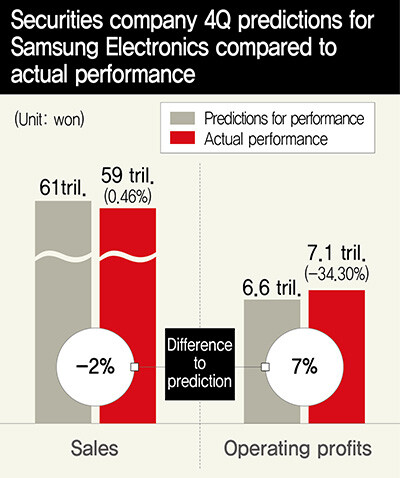hankyoreh
Links to other country sites 다른 나라 사이트 링크
Samsung semiconductor performance exceeds market expectations

Amid predictions that prices of memory semiconductors will rebound in 2020, operating profits released by Samsung Electronics have exceeded market expectations. Sales of semiconductors and high-priced foldable smartphones appear to have offset a downturn in the display division. Stock prices of Samsung Electronics and other manufacturers of memory semiconductors rose sharply, propelled by expectations of a recovery in the sector.
In Samsung Electronics’ announcement of estimated performance figures for the fourth quarter of 2019 on Jan. 8, sales stood at 59 trillion won (US$50.9 billion) and operating profits at 7.1 trillion won (US$6.12 billion). The sales figures were 0.46% higher than the same period last year, but didn’t meet the 61 trillion won (US$52.5 billion) predicted by the market. Operating profits, despite dropping by 34.3%, still beat market predictions of 6.6 trillion won (US$5.69 billion). Calculating Samsung’s 2019 performance using the estimates released on Wednesday shows sales of 230 trillion won (US$198.31 billion) and operating profits around 28 trillion won (US$24.18 billion). Compared to 2018, sales and profit were down by 5.8%, and 52.9%, respectively.
“Since total sales didn’t meet market predictions, the growth in operating profits should be regarded as a one-off event resulting from improved semiconductor sale prices and shipment volumes in December 2019 rather than being driven by higher turnover,” said Kim Seon-u, an analyst at Meritz Securities.
In regard to displays, Kim said, “Operating profits plummeted from 1.2 trillion won (US$1.03 billion) in the third quarter to 300 billion won (US$258.6 million) in the fourth quarter, likely because of falling prices of LCD panels and smaller shipments of OLED displays for iPhones.”
Price trends for memory semiconductors suggest that the price of DRAM and NAND flash, which dropped steeply last year, could recover this year. According to data released by market researcher DRAMeXchange, the average fixed transaction price for a 128-gigabyte MLC NAND flash semiconductor fell from US$4.52 in January to US$3.93 in May, but has risen since then, to US$4.01 in July, US$4.31 in November, and US$4.42 in December.
The average fixed transaction price for 8-gigabyte DDR4, a DRAM semiconductor for PCs, also fell rapidly throughout the first half of 2019, but the decline leveled off after that. During an appearance at CES, a consumer electronics show underway in Las Vegas, Samsung Electronics Vice Chairman Kim Ki-nam said that conditions are improving in the semiconductor market this year.
Amid growing expectations about an upturn in the semiconductor market, the stock prices of Samsung Electronics and other major semiconductor manufacturers rallied on Wednesday. At one point during trading, Samsung Electronics was up by more than 2%, while SK Hynix finished the day at 97,400 won (US$83.98), 3.62% higher than the previous day.
By Shin Da-eun, staff reporter
Please direct comments or questions to [english@hani.co.kr]

Editorial・opinion
![[Editorial] Penalties for airing allegations against Korea’s first lady endanger free press [Editorial] Penalties for airing allegations against Korea’s first lady endanger free press](https://flexible.img.hani.co.kr/flexible/normal/500/300/imgdb/original/2024/0502/1817146398095106.jpg) [Editorial] Penalties for airing allegations against Korea’s first lady endanger free press
[Editorial] Penalties for airing allegations against Korea’s first lady endanger free press![[Editorial] Yoon must halt procurement of SM-3 interceptor missiles [Editorial] Yoon must halt procurement of SM-3 interceptor missiles](https://flexible.img.hani.co.kr/flexible/normal/500/300/imgdb/child/2024/0501/17145495551605_1717145495195344.jpg) [Editorial] Yoon must halt procurement of SM-3 interceptor missiles
[Editorial] Yoon must halt procurement of SM-3 interceptor missiles- [Guest essay] Maybe Korea’s rapid population decline is an opportunity, not a crisis
- [Column] Can Yoon steer diplomacy with Russia, China back on track?
- [Column] Season 2 of special prosecutor probe may be coming to Korea soon
- [Column] Park Geun-hye déjà vu in Yoon Suk-yeol
- [Editorial] New weight of N. Korea’s nuclear threats makes dialogue all the more urgent
- [Guest essay] The real reason Korea’s new right wants to dub Rhee a founding father
- [Column] ‘Choson’: Is it time we start referring to N. Korea in its own terms?
- [Editorial] Japan’s rewriting of history with Korea has gone too far
Most viewed articles
- 160% of young Koreans see no need to have kids after marriage
- 2[Editorial] Japan’s rewriting of history with Korea has gone too far
- 3[Reporter’s notebook] In Min’s world, she’s the artist — and NewJeans is her art
- 4Hybe-Ador dispute shines light on pervasive issues behind K-pop’s tidy facade
- 5[Editorial] Penalties for airing allegations against Korea’s first lady endanger free press
- 6Presidential office warns of veto in response to opposition passing special counsel probe act
- 7Vietnamese war victims speak of sexual violence by S. Korean troops for the first time
- 8[Column] Park Geun-hye déjà vu in Yoon Suk-yeol
- 9Months and months of overdue wages are pushing migrant workers in Korea into debt
- 10The BTS story that no Koreans would have believed a generation ago